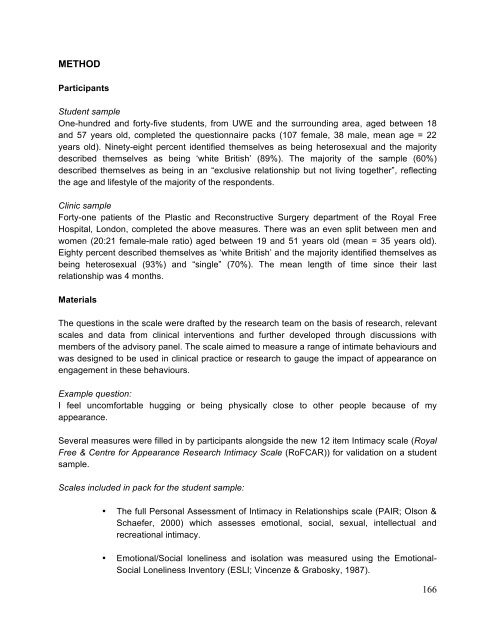Download the report - The Healing Foundation
Download the report - The Healing Foundation
Download the report - The Healing Foundation
You also want an ePaper? Increase the reach of your titles
YUMPU automatically turns print PDFs into web optimized ePapers that Google loves.
METHOD<br />
Participants<br />
Student sample<br />
One-hundred and forty-five students, from UWE and <strong>the</strong> surrounding area, aged between 18<br />
and 57 years old, completed <strong>the</strong> questionnaire packs (107 female, 38 male, mean age = 22<br />
years old). Ninety-eight percent identified <strong>the</strong>mselves as being heterosexual and <strong>the</strong> majority<br />
described <strong>the</strong>mselves as being ‘white British’ (89%). <strong>The</strong> majority of <strong>the</strong> sample (60%)<br />
described <strong>the</strong>mselves as being in an “exclusive relationship but not living toge<strong>the</strong>r”, reflecting<br />
<strong>the</strong> age and lifestyle of <strong>the</strong> majority of <strong>the</strong> respondents.<br />
Clinic sample<br />
Forty-one patients of <strong>the</strong> Plastic and Reconstructive Surgery department of <strong>the</strong> Royal Free<br />
Hospital, London, completed <strong>the</strong> above measures. <strong>The</strong>re was an even split between men and<br />
women (20:21 female-male ratio) aged between 19 and 51 years old (mean = 35 years old).<br />
Eighty percent described <strong>the</strong>mselves as ‘white British’ and <strong>the</strong> majority identified <strong>the</strong>mselves as<br />
being heterosexual (93%) and “single” (70%). <strong>The</strong> mean length of time since <strong>the</strong>ir last<br />
relationship was 4 months.<br />
Materials<br />
<strong>The</strong> questions in <strong>the</strong> scale were drafted by <strong>the</strong> research team on <strong>the</strong> basis of research, relevant<br />
scales and data from clinical interventions and fur<strong>the</strong>r developed through discussions with<br />
members of <strong>the</strong> advisory panel. <strong>The</strong> scale aimed to measure a range of intimate behaviours and<br />
was designed to be used in clinical practice or research to gauge <strong>the</strong> impact of appearance on<br />
engagement in <strong>the</strong>se behaviours.<br />
Example question:<br />
I feel uncomfortable hugging or being physically close to o<strong>the</strong>r people because of my<br />
appearance.<br />
Several measures were filled in by participants alongside <strong>the</strong> new 12 item Intimacy scale (Royal<br />
Free & Centre for Appearance Research Intimacy Scale (RoFCAR)) for validation on a student<br />
sample.<br />
Scales included in pack for <strong>the</strong> student sample:<br />
• <strong>The</strong> full Personal Assessment of Intimacy in Relationships scale (PAIR; Olson &<br />
Schaefer, 2000) which assesses emotional, social, sexual, intellectual and<br />
recreational intimacy.<br />
• Emotional/Social loneliness and isolation was measured using <strong>the</strong> Emotional-<br />
Social Loneliness Inventory (ESLI; Vincenze & Grabosky, 1987).<br />
166


